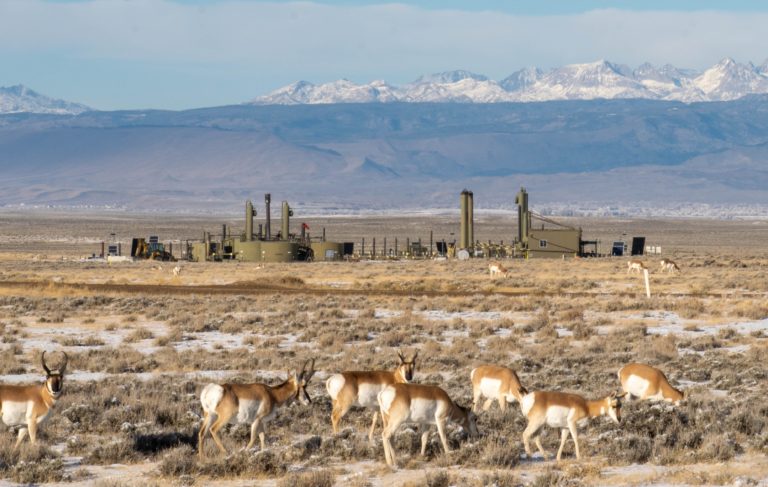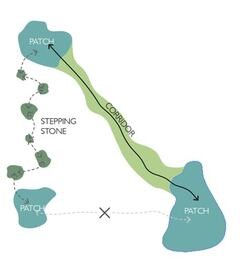
Conservation Is About Connectivity
By Karen Schumacher
It is often difficult to explain something that doesn’t make sense in a way that it does make sense. Starting with the foundation of the insanity may be the place to start.
It was previously revealed that the Bureau of Land Management (BLM) adheres to international standards for conservation. Although “fragmentation” and “habitat” are frequently referenced in the Upper Snake East Travel Management Plan Draft Environmental Assessment in relation to multiple different types of species, the word connectivity isn’t really prominent. One purpose of moving and decreasing the number of these trails is to repair fragmentation and restore land for connectivity.
Habitat connectivity is the insane notion that because of human activity, roads, and development, habitat becomes fragmented. In other words, the land that maintains connectivity, corridors and stepping stones, is disrupted. In the graphic below, it is conceived that there must be a connection between patches in order to maintain connectivity. This habitat includes all ecological elements, including vegetation and wildlife. If damaged, that area must be restored in order to re-establish connectivity. Maintaining connectivity protects biodiversity, or so they say.

The 2021 White House America the Beautiful initiative, which outlined its conservation goals, includes its 30×30 agenda, a plan to conserve 30% of land by 2030. Other than declaring more national monuments for banned use, it has taken two years until now to get going on this. However, it now appears the aggressive move is on for placing land into conservation. It is clear that using habitat connectivity is at the core of meeting the 30×30 goal.
In March 2023, the Council on Environmental Quality (CEQ) put out a memo that outlined the new requirement that all public land use planning must include connectivity. Maybe the Chair should have checked with the BLM, as it had already instituted this policy in November, 2022. Somehow, the BLM sees ““wildlife and fish” as one of the resources expressly included in the definition of “multiple use” (Section 103(c)” in the Federal Land Management & Policy Act (FLPMA), and justifying its use for connectivity.
BLM land must now be evaluated to determine “if existing land use plan decisions are (or are not) restoring, maintaining, improving, and/or conserving areas of habitat connectivity” and “incorporate areas of habitat connectivity”. From that, the land use will be planned around habitat connectivity, which plays into where and why trails are being moved and reduced, as this policy includes “Travel management implementation”.
The Center for Large Landscape Conservation (CLLC) and Network for Landscape Conservation (NLC) are two organizations ready to jump on this as connectivity is their heart.
As the name implies, the NLC is a network of environmental groups as well as government agencies such as the U.S. Forest Service. In February, 2023 it held a webinar that discussed “Insights into the new Global Biodiversity Framework” (GBF) that came out of COP 15, held in December, 2022. Also attending COP 15 were officials from the Biden, State, and USAID departments. Even though the U.S. is not a signatory of the Convention on Biological Diversity, it is an “observer” to support the GBF, its outcomes in America, and its 30×30 agenda. The CEQ Chair, the one who can’t keep dates straight, was also present, lending her support and commitment to the GBF. The GBF also meets the 2030 Agenda for Sustainable Development.
Along with CLLC celebrating this framework, both of these two organizations have had direct influence on government policies on integrating habitat and wildlife connectivity into federal planning and decisions. The White House Council on Environmental Quality issued guidelines that “incorporate the objectives in this guidance into agency actions”. Travel Management Plans are one area where this connectivity agenda is being used.
There are four GBF goals. Goal A focuses on “the integrity, connectivity and resilience of all ecosystems are maintained, enhanced, or restored”.
Within these 4 goals are 23 targets to be met by 2030. This is the core of 30×30, using biodiversity to take land for conservation as outlined in Target 2. The America the Beautiful 30×30 agenda originates from Target 3 which ensures the conservation of 30% of the land and inland waters. Target 4 calls for “management actions to halt human induced extinction of known threatened species and for the recovery and conservation of species”. Target 14 ensures “the full integration of biodiversity and its multiple values into policies, regulations, planning and development processes” which are being implemented through the BLM.
Following COP 15 in March 2023, the White House Council on Environmental Quality issued guidelines “for ecological connectivity and wildlife corridors” that “incorporate the objectives in this guidance into agency actions”. Travel Management Plans are not the only area where this connectivity agenda will be used.
In a NLC webinar, as attendees to COP 15, it was discussed how the GBF is part of the America the Beautiful 30×30 agenda, and as a U.S. observer, it will help to implement GBF objectives. Indigenous rights were also heavily emphasized. Not surprisingly, it was also revealed that about 2,000 corporations were present at COP 15 to develop markets for this agenda, Nature Action 100 being one of them. Like the proposed conservation leasing, public land is being monetized, not for our right to use the land, but to conserve it for the purposes of making money for the government.
The Department of Interior (DOI) also held its own little party in March of this year, celebrating its conservation agenda, even with Biden in attendance, who gave kudos to Rep. Mike Simpson “to bring healthy and abundant salmon runs back to the Colorado [Columbia] River system.” (This is in reference to Simpson wanting to remove dams. Parenthesis is to fix Biden’s gaffe. His remarks begin at the 37″ mark in the video). Nice to know we have an Idaho representative enmeshed with a president and not the people. Biden even referenced running roughshod over private land for this agenda.
In the video of the DOI event, there were multiple Native American speakers and again, a very heavy emphasis on Indigenous rights. At the 11:25 mark, CEQ Chair Brenda Mallory, a COP 15 attendee, spoke. She mentioned the same, connecting habitat across private land, infusing equity and justice into the use of land, and was excited the president could do all of this by just using his pen.
So, the upshot is that public land agencies will be integrating connectivity into all land planning, resulting in a reduction of land use for the protection of biodiversity, as outlined by organizations in which these agencies have made international agreements. Also on the horizon, these agencies are looking to monetize this work, making the land a money-making machine for them. Who then will control how the land is used? Be on the lookout for GBF implementation on BLM and other public land in your area. Land use planning is now about connectivity and eliminating the use of land. Understand your enemy. Watch the videos. These directives are not based on the law.
It is nearly impossible to find any government agency that is not tied in with corporations, foreign governments, environmental and other radical non-profit groups, and despotic organizations such as the UN. The U.S. has not followed the Constitution for decades. Until this is realized by all, and choose to do something about it, we will fail in getting our country back.